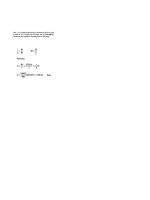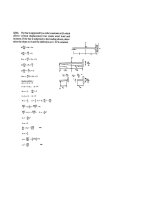Lecture Mechanics of materials (Third edition) - Chapter 11: Energy methods
Bạn đang xem bản rút gọn của tài liệu. Xem và tải ngay bản đầy đủ của tài liệu tại đây (928.64 KB, 10 trang )
<span class='text_page_counter'>(1)</span><div class='page_container' data-page=1>
<b>MECHANICS OF </b>
<b>MATERIALS</b>
<b>Ferdinand P. Beer</b>
<b>E. Russell Johnston, Jr.</b>
<b>John T. DeWolf</b>
<b>Lecture Notes:</b>
<b>J. Walt Oler</b>
<b>Texas Tech University</b>
CHAPTER
</div>
<span class='text_page_counter'>(2)</span><div class='page_container' data-page=2>
Energy Methods
Strain Energy
Strain Energy Density
Elastic Strain Energy for Normal Stresses
Strain Energy For Shearing Stresses
Sample Problem 11.2
Strain Energy for a General State of Stress
Impact Loading
Example 11.06
Example 11.07
Design for Impact Loads
Work and Energy Under a Single Load
Deflection Under a Single Load
Sample Problem 11.4
Work and Energy Under Several Loads
Castigliano’s Theorem
</div>
<span class='text_page_counter'>(3)</span><div class='page_container' data-page=3>
• A uniform rod is subjected to a slowly increasing load
• The <i>elementary work</i> done by the load P as the rod
elongates by a small <i>dx</i> is
which is equal to the area of width <i>dx</i> under the
load-deformation diagram.
<i>work</i>
<i>elementary</i>
<i>dx</i>
<i>P</i>
<i>dU</i> = =
• The <i>total work</i> done by the load for a deformation <i>x</i><sub>1</sub>,
<i>energy</i>
<i>strain</i>
<i>work</i>
<i>total</i>
<i>dx</i>
<i>P</i>
<i>U</i>
<i>x</i>
=
=
=
∫
1</div>
<span class='text_page_counter'>(4)</span><div class='page_container' data-page=4>
Strain Energy Density
• To eliminate the effects of size, evaluate the
strain-energy per unit volume,
<i>density</i>
<i>energy</i>
<i>strain</i>
<i>d</i>
<i>u</i>
<i>L</i>
<i>dx</i>
<i>A</i>
<i>P</i>
<i>V</i>
<i>U</i>
<i>x</i>
<i>x</i>
=
=
=
∫
∫
1
1
0
0
ε
ε
σ
• The total strain energy density resulting from the
deformation is equal to the area under the curve to
ε
<sub>1</sub>.• As the material is unloaded, the stress returns to zero
but there is a permanent deformation. Only the strain
energy represented by the triangular area is recovered.
• Remainder of the energy spent in deforming the material
</div>
<span class='text_page_counter'>(5)</span><div class='page_container' data-page=5>
Strain-Energy Density
• The strain energy density resulting from
setting
ε
<sub>1</sub>= ε
<i><sub>R</sub></i> is the <i>modulus of toughness</i>.• The energy per unit volume required to cause
the material to rupture is related to its ductility
as well as its ultimate strength.
• If the stress remains within the proportional
limit,
<i>E</i>
<i>E</i>
<i>d</i>
<i>E</i>
<i>u</i> <i><sub>x</sub></i>
2
2
2
1
2
1
0
1
1 ε σ
ε
ε
ε
=
=
</div>
<span class='text_page_counter'>(6)</span><div class='page_container' data-page=6>
Elastic Strain Energy for Normal Stresses
• In an element with a nonuniform stress distribution,
energy
strain
total
lim
0
=
=
=
∆
∆
=
∫
→
∆ <i>dV</i> <i>U</i> <i>u</i> <i>dV</i>
<i>dU</i>
<i>V</i>
<i>U</i>
<i>u</i>
<i>V</i>
• For values of <i>u</i> < <i>u<sub>Y</sub></i>, i.e., below the proportional
limit,
<i>energy</i>
<i> strain</i>
<i>elastic</i>
<i>dV</i>
<i>E</i>
<i>U</i> <i>x</i>
2
2
∫
== σ
• Under axial loading, σ<i><sub>x</sub></i> = <i>P</i> <i>A</i> <i>dV</i> = <i>A</i> <i>dx</i>
∫
=
<i>L</i>
<i>dx</i>
<i>AE</i>
<i>P</i>
<i>U</i>
0
2
2
<i>AE</i>
<i>L</i>
<i>P</i>
<i>U</i>
2
2
=
</div>
<span class='text_page_counter'>(7)</span><div class='page_container' data-page=7>
Elastic Strain Energy for Normal Stresses
<i>I</i>
<i>y</i>
<i>M</i>
<i>x</i> =
σ
• For a beam subjected to a bending load,
∫
∫
== <i>dV</i>
<i>EI</i>
<i>y</i>
<i>M</i>
<i>dV</i>
<i>E</i>
<i>U</i> <i>x</i>
2
2
2
2
2
2
σ
• Setting <i>dV = dA dx,</i>
<i>dx</i>
<i>EI</i>
<i>M</i>
<i>dx</i>
<i>dA</i>
<i>y</i>
<i>EI</i>
<i>M</i>
<i>dx</i>
<i>dA</i>
<i>EI</i>
<i>y</i>
<i>M</i>
<i>U</i>
<i>L</i>
<i>L</i>
<i>A</i>
<i>L</i>
<i>A</i>
∫
∫
∫
∫ ∫
=
⎟
⎟
⎠
⎞
⎜
⎜
⎝
⎛
=
=
0
2
0
2
2
2
0
2
2
2
2
2
2
</div>
<span class='text_page_counter'>(8)</span><div class='page_container' data-page=8>
Strain Energy For Shearing Stresses
• For a material subjected to plane shearing
stresses,
∫
=
<i>xy</i>
<i>xy</i>
<i>xy</i> <i>d</i>
<i>u</i>
γ
γ
τ
0
• For values of
τ
<i><sub>xy</sub></i> within the proportional limit,<i>G</i>
<i>G</i>
<i>u</i> <i><sub>xy</sub></i> <i><sub>xy</sub></i> <i><sub>xy</sub></i> <i>xy</i>
2
2
2
1
2
2
1 γ <sub>=</sub> τ γ <sub>=</sub>τ
=
• The total strain energy is found from
∫
∫
=
=
<i>dV</i>
<i>G</i>
<i>dV</i>
<i>u</i>
<i>U</i>
<i>xy</i>
2
2
</div>
<span class='text_page_counter'>(9)</span><div class='page_container' data-page=9>
Strain Energy For Shearing Stresses
<i>J</i>
<i>T</i>
<i>xy</i>
ρ
τ =
∫
∫
== <i>dV</i>
<i>GJ</i>
<i>T</i>
<i>dV</i>
<i>G</i>
<i>U</i> <i>xy</i>
2
2
2
2
2
2
ρ
τ
• For a shaft subjected to a torsional load,
• Setting <i>dV = dA dx,</i>
</div>
<span class='text_page_counter'>(10)</span><div class='page_container' data-page=10>
Sample Problem 11.2
SOLUTION:
• Determine the reactions at <i>A</i> and <i>B</i>
from a free-body diagram of the
complete beam.
• Develop a diagram of the bending
moment distribution.
a) Taking into account only the normal
stresses due to bending, determine the
strain energy of the beam for the
loading shown.
b) Evaluate the strain energy knowing
that the beam is a W10x45, <i>P</i> = 40
kips, <i>L</i> = 12 ft, <i>a</i> = 3 ft, <i>b</i> = 9 ft, and <i>E</i>
= 29x106 <sub>psi.</sub>
• Integrate over the volume of the
beam to find the strain energy.
• Apply the particular given
</div>
<!--links-->









